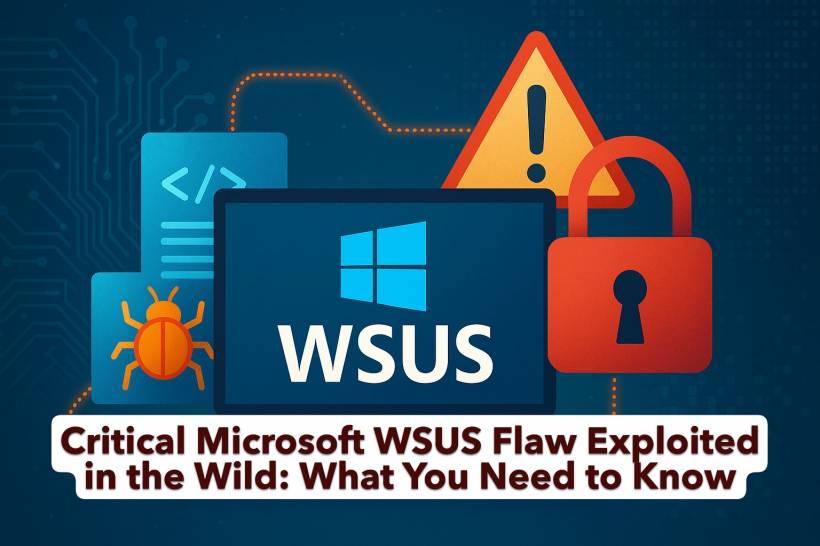When Microsoft releases an urgent patch, it's usually serious—but this time, it's critical. A newly discovered flaw in Windows Server Update Services (WSUS) has sent ripples across the cybersecurity world. The vulnerability, officially tagged CVE-2025-59287, allows attackers to remotely execute code on unpatched systems—without any user interaction. In short, it's a hacker's dream and an admin's nightmare.
Let's unpack what's happening, why it matters, and how to defend your systems.
Understanding WSUS and Why It's Targeted
WSUS is a familiar name in IT departments—it's the backbone that distributes Windows updates across large organizations. By acting as a centralized patch hub, it saves bandwidth and provides administrators with control over what updates are deployed and when.
But that centralization comes with risk. A compromised WSUS server is like a poisoned water supply: if attackers gain control, they can push malicious updates to every connected machine. That's why a flaw in WSUS doesn't just endanger one server—it threatens the entire network.
What Makes CVE-2025-59287 So Dangerous
This vulnerability stems from how WSUS handles deserialization of untrusted data using an outdated serialization mechanism. In layman's terms, WSUS can be tricked into running attacker-provided code because it doesn't properly validate the data it's reading.
The flaw is rated 9.8 out of 10 on the CVSS scale, placing it firmly in the "Critical" category. To make matters worse, it requires no privileges or user interaction—an attacker just needs network access to an exposed WSUS server.
Once exploited, this vulnerability allows full remote code execution (RCE), meaning hackers can run any command they like under the SYSTEM account. That includes installing malware, exfiltrating data, or even pivoting across the corporate network. It's as bad as it sounds.
Real-World Exploitation: Not Just a Theoretical Threat
This isn't a "maybe someday" problem—the vulnerability is already being exploited in the wild. The U.S. Cybersecurity and Infrastructure Security Agency (CISA) has added it to its Known Exploited Vulnerabilities (KEV) list, confirming that attackers are actively targeting vulnerable servers.
Security researchers have spotted attacks using Base64-encoded .NET payloads hidden within HTTP requests to WSUS. These payloads evade traditional logging by disguising themselves in custom HTTP headers—one example uses a header named 'aaaa'. The attack chain aligns closely with a proof-of-concept (PoC) exploit that surfaced shortly after the vulnerability became public, accelerating global exploitation attempts.
How the Attack Works (Without Getting Too Technical)
The attack starts with an unauthenticated HTTP POST request sent to WSUS's ClientWebService endpoint on port 8530. The payload is wrapped inside a SOAP envelope, disguised as part of normal WSUS communication.
Here's the nasty part: WSUS uses a hardcoded key to decrypt the data from a field called AuthorizationCookie. After stripping out an initialization vector (IV), the system deserializes the result using .NET's BinaryFormatter—a process known for being unsafe when handling untrusted input.
In testing, the PoC exploit simply launched "calc.exe" as proof of execution. But in the hands of an attacker, it could deploy ransomware, create backdoors, or compromise Active Directory environments.
Affected Systems: Who's at Risk
The vulnerability affects nearly all modern Windows Server versions that have the WSUS role installed, including:
It's important to note that WSUS isn't enabled by default. However, organizations using it for internal update management are immediately exposed if they haven't patched. Given WSUS's privileged position, even a single unpatched instance can compromise an entire domain.
Recommended Actions: Don't Wait to Patch
Both Microsoft and CISA have urged organizations to take immediate action. Here's what to do:
1. Identify Vulnerable Servers
Run internal scans to locate systems with the WSUS role enabled and open ports 8530 or 8531. These ports are the primary entry points for this exploit.
2. Apply the Latest Microsoft Patch
Microsoft has released an out-of-band update to fix this issue. Install it immediately and reboot your servers to ensure the patch is fully applied. Skipping the reboot may leave the vulnerability partially exposed.
3. Temporary Workarounds
If patching isn't possible right away:
These are stopgap measures—don't rely on them long-term.
4. Strengthen Monitoring
Deploy monitoring or intrusion detection tools to flag unusual WSUS activity, especially suspicious GetCookie() calls or traffic containing Base64 payloads. These patterns often signal active exploitation attempts.
Why Legacy Components Still Pose a Modern Risk
This incident underscores a recurring problem in enterprise environments: legacy components that linger for years because they "just work." WSUS has been around since the Windows Server 2003 era, and while still functional, its underlying design wasn't built for today's threat landscape.
Features like unsafe serialization mechanisms are relics of an older development philosophy—one that prioritizes convenience over security. As organizations modernize, it's crucial to assess which legacy tools might be ticking time bombs.
The Bigger Picture: From Patch Management to Risk Management
Ironically, WSUS was designed to keep systems secure through timely updates. But as this event shows, even the patching infrastructure itself can become a weak link if not maintained.
Cybersecurity isn't just about applying patches—it's about managing risk across every layer. Regular vulnerability scanning, segmented network design, and rapid incident response all play vital roles in minimizing exposure.
Final Thoughts
The WSUS remote code execution vulnerability is a wake-up call for IT administrators and security professionals alike. With public PoC exploits, confirmed active attacks, and a near-perfect CVSS score, this is one of those "drop everything and patch" situations.
If your organization uses WSUS, treat this as a top priority. Patch now, monitor continuously, and use this opportunity to review other legacy systems that might quietly be waiting to fail you next.




